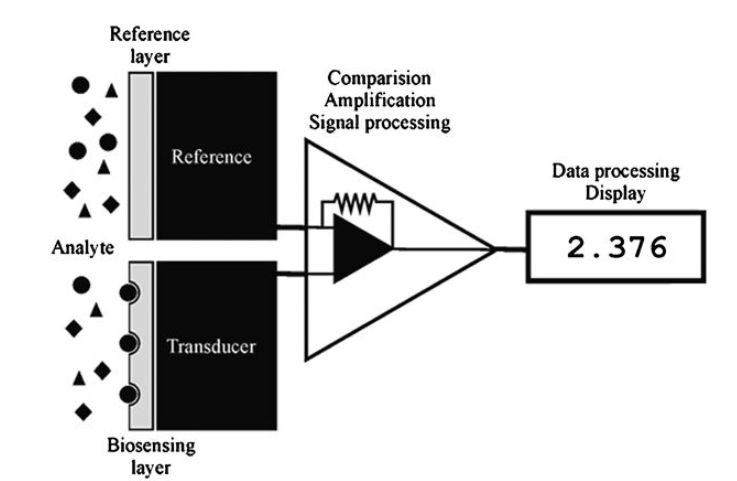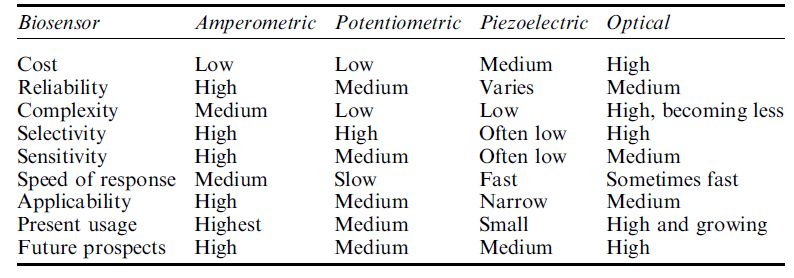


 النبات
النبات
 الحيوان
الحيوان
 الأحياء المجهرية
الأحياء المجهرية
 علم الأمراض
علم الأمراض
 التقانة الإحيائية
التقانة الإحيائية
 التقنية الحيوية المكروبية
التقنية الحيوية المكروبية
 التقنية الحياتية النانوية
التقنية الحياتية النانوية
 علم الأجنة
علم الأجنة
 الأحياء الجزيئي
الأحياء الجزيئي
 علم وظائف الأعضاء
علم وظائف الأعضاء
 الغدد
الغدد
 المضادات الحيوية
المضادات الحيوية|
Read More
Date: 20-1-2021
Date: 16-1-2021
Date: 15-1-2021
|
Introduction to Biosensors
Biosensors are analytical devices that convert biological actions into electrical signals in order to quantify them. In this chapter, only biosensors that make use of the specificity of biological processes are described, that is, the recognition of enzymes for their substrates or other ligands, antibodies for their antigens, lectins for carbohydrates and nucleic acids or peptide nucleic acids for their complementary sequences. Biosensor science is interdisciplinary, bringing together chemistry, physics, biology, electronics and engineering to solve realworld analytical problems. The parts of a typical biosensor are shown in Figure 1. The primary advantage of using biologically active molecules as part of a biosensor is due to their high specificity and, hence, high discriminatory power. Thus, they are generally able to detect particular molecular species from within complex mixtures of other materials with similar structure that may be present at comparable or substantially higher concentrations. Often, samples can be analysed with little or no prior clean-up. In this respect they show distinct advantages over most ‘traditional’ analytical methods; for example, colorimetric assays such as the Lowry assay for proteins.

Figure .1 The functional units of a biosensor. The biological reaction usually takes place in close contact with the electrical or optical transducer, here shown as a ‘black-box’. This intimate arrangement ensures that most of the biological reaction is detected. The resultant electrical or optical signal is compared with a reference signal that is usually produced by a similar system without the biologically active material. The difference between these two signals, which optimally is proportional to the material being analysed (i.e. the analyte), is amplified, processed and displayed or recorded. The reference electrode stabilises the output, so reducing signal drift and improving reproducibility.
Biosensors may serve a number of analytical purposes. In some applications, for example in clinical diagnosis, it is sometimes important only to determine whether the analyte is above or below some predetermined threshold, whereas in process control there often needs to be a continual accurate but imprecise feedback of the level of analyte present. In the former case, the biosensor must be designed to give the minimum number of false positives and, more importantly, false negatives. In the latter case, it is generally the rapid response to changes in the analyte that is more important than its absolute precision. Minimising false negatives is often more important in clinical analyses than minimising false positives, as in the former case a diagnosis may be missed and therapy delayed whereas in the latter case further tests may show the error. Other biosensor analytical applications may require accuracy and precision over a wide analytical range.
Biosensors must show advantages over the use of the free active biomolecules, which possess at least equal specificity and discriminatory power, if they are to be acceptable. Their main advantages usually involve rapid response, the reduced need for sample pretreatment, their ease of use and often their reusability and portability. Repetitive reuse of the same biologically active sensing material generally ensures that similar samples give similar responses as any need for accurate aliquoting of such biological materials to contain precisely similar activity is avoided. This circumvents the possibility of introducing errors by inaccurate pipetting or dilution and is a necessary prerequisite for automated and on-line monitoring. Repetitive and reagentless methodology offers considerable savings in terms of reagent costs, so reducing the cost per assay. In addition, the increased operator time per assay and the associated higher skill required for ‘traditional’ assay methods also involves a cost penalty which is often greater than that due to the reagents. These advantages must be sufficient to encourage the high investment necessary for the development of a biosensor and the purchase price to the end-user. Table .1 lists a number of important attributes that a successful biosensor may be expected to possess. In any particular case only some of these may be achievable.
Table .1 The properties required of a successful biosensor.

Table.2 The properties of some important biosensor configurations. Constant development reduces the more negative features when large-scale production is planned.

The different types of biosensors have their own advantages and disadvantages that are summarised in Table 2. Apart from the important related area of colorimetric test strips, the most important commercial biosensors are electrochemical, but the principal area of new development is optical. There are amperometric biosensors available for glucose, lactate, glycerol, ethanol, lactose, L-amino acids, cholesterol, fish freshness and microorganisms. Potentiometric devices have been marketed for glucose, other low molecular weight carbohydrates and alcohols. Receptor-based and immunosensors have been marketed utilising surface plasmon resonance devices and piezocrystals.
Most of the market share for biosensor applications is for glucose analysis for use in the monitoring and control of diabetes. Only a few years ago, market research projections for the growth of the biosensor industry predicted expansion at an impressively fast pace of almost 50% per year. These were over-optimistic, with current growth being about 10%. However, industry sales as a whole were expected to be worth about $5000 million in 2007. Although currently over 1000 scientific papers on biosensors are published each year, biosensor science has not progressed as significantly as other areas of modern biotechnology. A vast number of biosensor systems have been published, some being very imaginative, but with just a few reaching the marketplace and even these often utilise well-established ideas. It is now accepted that there are substantial and investment-intensive difficulties involved in producing such robust and reliable commercial analytical devices that are able to operate under authentic real-life conditions, even where a novel and highly promising prototype device has been produced. The cost of the biosensor is often of importance and considerable effort has been expended in the production of disposable devices using cheap integrated chip technology; disposable technology offering opportunities for continuing and increased revenue. Such silicon-based methodology has opened up the possibility of having a number of different sensors on one device, allowing multi-parameter assays. A realistic target for the future is a density of a million sensors per square centimetre. However, there must be a demand for very large numbers of such devices in order for their production to be economically viable. Relatively unsophisticated processes, involving screen printing or ink-jet technologies, are currently preferred, due to their lower start-up costs, whereas photolithography can be used for the production of sub-micron structures with well-defined geometry.
By far the largest biosensor application area is in clinical diagnostics. This includes monitoring of critical metabolites during surgery. The major target markets are concerned with use for self-testing at home, within the physician’s office for screening and within casualty and other hospital departments for point-of-care diagnosis. These application areas are potentially very wide. The use of rapid biosensor techniques in doctors’ surgeries and in hospitals avoids the need for expensive and, most importantly, time-consuming testing at central clinical laboratories.
Thus diagnosis and treatment may start during the first visit of a patient. This removes the need to wait for a return visit after the clinical tests have been completed elsewhere and allowing time, perhaps, for the patient’s condition to deteriorate somewhat. Also, there is less likelihood
of the sample being mishandled or contaminated. As an example, testing for diabetes using glucose biosensors is now routine even if a patient has an apparently unrelated complaint. Centralised clinical analytical facilities remain a necessity due to the need, in many cases, for multiple different analyses on the same sample and difficulties such as regulatory compliance. Legislation and the increasing possibility of medical malpractice claims often impose stringent quality assurance and control standards on clinical analyses. This makes it much more expensive to bring novel clinical biosensors to the marketplace today than in the past, but generally allows those biosensors that are already established, giving them a distinct competitive edge.
Home diagnosis and testing is an area that is being opened up by, for example, pregnancy and ovulation test kits, blood cholesterol testing and diabetes control. Clearly, there are risks and problems involved with their more widespread use, but many people prefer to use them as indications for whether a trip to the doctor’s surgery is really necessary or not. As counselling may be necessary with some potential home diagnosis applications (for example, cancer and AIDS), controversy exists over their development.
One of the major potential uses for biosensors is for in vivo applications such as for the close control of diabetes. The purpose here is to monitor continuously the levels of metabolites such that corrective action can be employed immediately when necessary. Clearly, such biosensors must be biocompatible and miniaturised so that they are implantable. In addition, they should be reagentless, the reaction being controlled only by the presence of the metabolite and the stabilised bioreagent. The signal generated must be drift free over the period of interest. At the present time, such biosensors have a relatively short lifespan of a few days at most, due mainly to problems which arise from the body’s response.
Industrial analyses involve food, cosmetics and fermentation process control and quality control and monitoring. The defence industry is interested in detectors for explosives, nerve gases and microbial spores and toxins. Environmental uses of biosensors are mainly in areas of water quality and pollution control. A typical application might be to detect parts per million of particular molecular species such as an industrial toxin within the highly complex mixtures produced as process effluent.



|
|
|
|
لخفض ضغط الدم.. دراسة تحدد "تمارين مهمة"
|
|
|
|
|
|
|
طال انتظارها.. ميزة جديدة من "واتساب" تعزز الخصوصية
|
|
|
|
|
|
|
مشاتل الكفيل تزيّن مجمّع أبي الفضل العبّاس (عليه السلام) بالورد استعدادًا لحفل التخرج المركزي
|
|
|